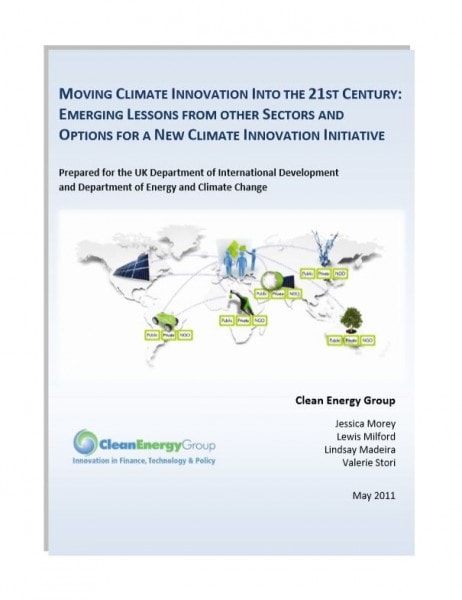May 11, 2011
Turning Climate Tech Transfer on its Head
By Lewis Milford, Jessica Morey

We reached many conclusions but the most surprising is this: contrary to conventional wisdom, breakthroughs in climate technology are likely to come from developing countries. This view directly confronts prevailing notions that climate solutions will happen only with massive funding for ‘North to South’ technology transfer.
That is the international climate path now. The international community has been principally committed to meeting the climate technology needs of developing countries through technology transfer from the North to the South. It has then struggled to come up with ways to raise trillions of dollars to pay for that transfer.
The IPCC has broadly defined technology transfer to include “flows of know-how, experience and equipment” among a large range of stakeholders, without stipulating who transfers and who receives. However, the UNFCCC Articles and reports almost exclusively refer to tech transfer as a process whereby the rich world provides expensive technologies invented in the North to the South. As one UN report says “The focus of implementation has generally been on creating conditions in developing countries conducive to foreign investment and building capabilities to absorb and utilize imported technologies.”
Put simply, this conception of technology transfer relies heavily on official development assistance and posits developing countries as passive recipients of technology. Climate technology is then a one- way, conventional development aid strategy. And this conventional strategy will come at a huge cost – studies show that this form of transfer could cost trillions of dollars.
Our research in innovation theory and practical experience, however, shows that this thinking may be wrong – or at least other approaches are needed. That is because we believe many of the breakthroughs for low carbon technologies are likely to come from the developing world and then transferred to the West.
The conditions for climate technology innovation in the developing world are, surprisingly enough, far more conducive to the invention and scaling of new disruptive technologies than the OECD.
One of the most compelling and surprising new innovation trends is called “reverse innovation.” This trend is far removed from purely academic theory. Rather, it is an operating strategy for major global corporations doing business in the developing world, with implications for how climate technology could develop.
Reverse innovation means designing, creating, and manufacturing a product in a developing country. A global partner may work with a local company in most cases. The product may initially be designed to meet developing world demands for lower cost and different performance factors, but global companies now use this “bottom of the pyramid” market strategy to create products that are later exported to the developed world.
Jeffrey Immelt, the CEO of General Electric, and his co-authors at Tuck Business School at Dartmouth, coined the term “reverse innovation” in the Harvard Business Review. The article describes two new medical devices—a $1,000 handheld electrocardiogram device and a $15,000 portable ultrasound machine—that were originally developed for markets in rural India and China. These radically cheap devices are now being sold in the US and Europe.
Immelt puts it bluntly that “If GE’s businesses are to survive and prosper in the next decade, they must become … adept at reverse innovation.”
And it is not just emerging economies that have innovative capacity to lead the way. As our case study on mobile phones shows, African and other developing countries are also developing innovations to transfer to the West.
Lighting Africa is one such example in the energy field. It is a very successful program through the World Bank and IFC that has led to the development of solar lighting retailing as low as US$22- before the program these products were hundreds of dollars more- beyond the reach of rural households without subsidies from development programs. These technologies are cheaper today because Lighting Africa through technology competitions and network creation was able to tap the creativity of African and international entrepreneurs to develop new products and business models.
Given these realities, the climate community should move away from the misleading term “tech transfer.” Let’s start talking about technology partnerships- where businesses, entrepreneurs and consumers in developing countries are not just passive recipients of technologies but active and creative problem solvers and indeed, initiators of innovation and technology development.
This is just not a change of terms. There are benefits for the rich world in these trends—through them we gain access to the developing world’s culture of frugality.
The rich world also needs cheaper climate technologies to meet the ambitious targets set by climate science and our governments. New technologies are up against powerful energy incumbent technologies—hampering our incentives to develop new technologies and build markets—and economic pressures are limiting the political will to pay for more expensive clean technologies. Many developing countries don’t have this industrial/infrastructure legacy.
Effective technology partnerships are a way to bridge the innovation needs of the rich and the poor. The developing world is focused on ultra-low cost “frugal innovation.” This is also just what the rich world needs for low-carbon technologies to compete against fossil fuel alternatives that must be replaced.
Finally, our report recommends that countries should quickly come together to begin to design an initiative to act as a catalyst for climate innovation in developing countries. If no entity has the job to do it, it won’t happen. New models and approaches are needed now more than ever.














